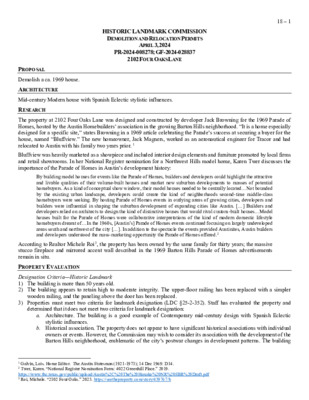18.0 - 2102 Four Oaks Ln — original pdf
Backup

18 – 1 HISTORIC LANDMARK COMMISSION DEMOLITION AND RELOCATION PERMITS APRIL 3, 2024 PR-2024-008278; GF-2024-028837 2102 FOUR OAKS LANE PROPOSAL Demolish a ca. 1969 house. ARCHITECTURE RESEARCH Mid-century Modern house with Spanish Eclectic stylistic influences. The property at 2102 Four Oaks Lane was designed and constructed by developer Jack Browning for the 1969 Parade of Homes, hosted by the Austin Homebuilders’ association in the growing Barton Hills neighborhood. “It is a home especially designed for a specific site,” states Browning in a 1969 article celebrating the Parade’s success at securing a buyer for the house, named “Bluffview.” The new homeowner, Jack Magners, worked as an aeronautical engineer for Tracor and had relocated to Austin with his family two years prior. 1 Bluffview was heavily marketed as a showpiece and included interior design elements and furniture promoted by local firms and retail showrooms. In her National Register nomination for a Northwest Hills model home, Karen Twer discusses the importance of the Parade of Homes in Austin’s development history: By building model houses for events like the Parade of Homes, builders and developers could highlight the attractive and livable qualities of their volume-built houses and market new suburban developments to masses of potential homebuyers. As a kind of conceptual show window, their model houses needed to be centrally located…Not bounded by the existing urban landscape, developers could create the kind of neighborhoods second-time middle-class homebuyers were seeking. By hosting Parade of Homes events in outlying areas of growing cities, developers and builders were influential in shaping the suburban development of expanding cities like Austin. […] Builders and developers relied on architects to design the kind of distinctive houses that would rival custom-built houses…Model houses built for the Parade of Homes were collaborative interpretations of the kind of modern domestic lifestyle homebuyers dreamt of…In the 1960s, [Austin’s] Parade of Homes events continued focusing on largely undeveloped areas south and northwest of the city […]. In addition to the spectacle the events provided Austinites, Austin builders and developers understood the mass-marketing opportunity the Parade of Homes offered.2 According to Realtor Michele Roi3, the property has been owned by the same family for thirty years; the massive stucco fireplace and mirrored accent wall described in the 1969 Barton Hills Parade of Homes advertisements remain in situ. PROPERTY EVALUATION Designation Criteria—Historic Landmark 1) The building is more than 50 years old. 2) The building appears to retain high to moderate integrity. The upper-floor railing has been replaced with a simpler wooden railing, and the paneling above the door has been replaced. 3) Properties must meet two criteria for landmark designation (LDC §25-2-352). Staff has evaluated the property and determined that it does not meet two criteria for landmark designation: a. Architecture. The building is a good example of Contemporary mid-century design with Spanish Eclectic stylistic influences. b. Historical association. The property does not appear to have significant historical associations with individual owners or events. However, the Commission may wish to consider its association with the development of the Barton Hills neighborhood, emblematic of the city’s postwar changes in development patterns. The building 1 Galvin, Lois. Home Editor. The Austin Statesman (1921-1973); 14 Dec 1969: D14. 2 Twer, Karen. “National Register Nomination Form: 4022 Greenhill Place.” 2019. https://www.thc.texas.gov/public/upload/Austin%2C%20The%20Hanako%20NR%20SBR%20Draft.pdf 3 Roi, Michele. “2102 Four Oaks.” 2023. https://seetheproperty.com/story/439767/b exemplifies the goals of the Parade of Homes: a site-specific design with unique finishes and features that represented an excellent marketing opportunity for Jack Browning’s residential development endeavors. c. Archaeology. The property was not evaluated for its potential to yield significant data concerning the human history or prehistory of the region. d. Community value. The property was not evaluated for its ability to possess a unique location, physical characteristic, or significant feature that contributes to the character, image, or cultural identity of the city, the neighborhood, or a particular demographic group. e. Landscape feature. The property does not appear to retain a significant natural or designed landscape with artistic, aesthetic, cultural, or historical value to the city. 18 – 2 STAFF RECOMMENDATION Strongly encourage rehabilitation and adaptive reuse, but release the demolition permit upon completion of a City of Austin Documentation Package. LOCATION MAP 18 – 3 PROPERTY INFORMATION Photos 18 – 4 Demolition permit application, 2024 18 – 5 18 – 6 Historical Information Michele Roi, 2023: https://seetheproperty.com/story/439767/b The Austin Statesman (1921-1973); Austin, Tex.. 21 Sep 1969: 10. 18 – 7 The Austin Statesman (1921-1973); Austin, Tex.. 21 Sep 1969: 10. 18 – 8 The Austin Statesman (1921-1973); Austin, Tex.. 21 Sep 1969: 5 18 – 9 The Austin Statesman (1921-1973); Austin, Tex.. 28 Sep 1969: C1. The Austin Statesman (1921-1973); Austin, Tex.. 01 Oct 1969: A8. 18 – 10 The Austin Statesman (1921-1973); Austin, Tex.. 05 Oct 1969: C6. 18 – 11 18 – 12 LOIS GALVIN, Home Editor. The Austin Statesman (1921-1973); Austin, Tex.. 14 Dec 1969: D14. Permits 18 – 13